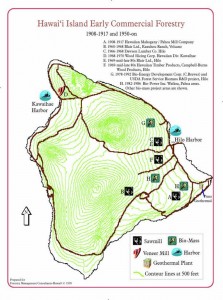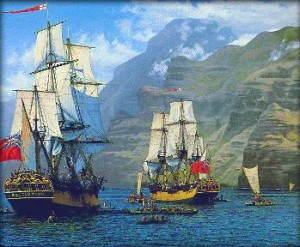The Weirdest Duck of Them All
For anyone who has a bucket list of world class archaeological sites they would like to visit, we suggest putting Kauai’s Makauhawi Cave Reserve, Hawaii’s largest limestone cave, one of the richest fossil sites on the islands and a uniquely preserved archaeological site–on the top of your list.
This integrated site reveals 10,000 years of strata containing fossil remains of plants and animals and spans prehistory to post colonization.  As the website says, “It’s a living museum dedicated not just to the past but also to experiments in native species conservation”.
The reserve, located on Grove Farm Co. lands, a Kauai company owned by former AOL/Time Warner Chief, Steve Case, is managed by Lida Pigott Burney and Dr. David Burney with the help of volunteers and contributors from around the globe. For an overview of progressive work on the site and maps see this pdf— supported by National Tropical Botanical Garden, Grove Farm and National Geographic.
The excavation provides a view of  the evolution of Hawaii’s forest environments.Pollen and seeds found in the pre-human layers reveal that many plants that are now rare, or only known from isolated or upland areas, were once part of a complex coastal forest. These finds led Burney to the theory that today’s dominant native forest trees like ‘ohi’a, hala and koa were once comparatively small parts of the forest ecosystem. Once the ecosystem was disturbed by human contact, these survivors were able to gain greater density as other plants disappeared.
“Probably the key difference between pre-human times and now is that the early forests were much more diverse”,  Burney stated in a 2005 Honolulu Advertiser article.  The complex coastal forest of the region has been intricately described from seed and pollen remains. Two species of plants — kou and hala — that were once believed to be Polynesian introductions have been proven to predate human arrival.
One of the most intriguing discoveries at the site is described on Dr. Burney’s blog, the Weirdest Duck of Them All.
Research, Visit and Discover
If you would like to find out more about the forests and forest industries of Hawai’i, here are a few sites and places to research, visit and discover.
Government
- Department of Hawaiian Home Lands
- Department of Land and Natural Resources – Division of Forestry and Wildlife
- State of Hawaii Forestry Website
Industry
Alliances and Partnerships
For Students and Further Research
- College of Tropical Agriculture and Human Resources – Hawai`i Forestry Extension
- State of Hawaii Kids Forest and Wildlife
- Trees of Hawai`i
- Hawaii Agriculture Research Center
- Hawaii Experimental Tropical Forest
- Pacific Island Ecosystems Research Center
- Commonly Planted Trees
- Native Trees of Hawai`i
- Hawaiian Native Plant Propagation Database
- Pacific Southwest Research Station USDA Forest Service
- Hawaii Tropical Forest Recovery Action Plan
- Hawaii Tropical Forest Recovery Act
- Puu Waawaa Dry Forest
- Laupahoehoe Wet Forest
Visit and Discover
- Bishop Museum
- Ka`upulehu Dryland Forest
- National Tropical Botanical Garden
- Amy B.H. Greenwell Ethnobotanical Garden
- Na ‘Āina Kai Botanical Garden
- Pana ‘ewa Zoo Discovery Forest
20th Century Commercial Forest Products Activities Hawai’i Island
Hawai’i Island Early Commercial Industry 1908-1917 and 1950-on
Click image to enlarge
Image copyright Forestry Management Consultants Hawai’i 1999
Late 1700s Timber Resources Meet Needs of Growing Industries
With the opening of Hawai‘i to the outside world after the arrival of Captain James Cook in 1778, Hawaii’s timber resources supplied the needs, particularly for fuel wood, of the many trading and whaling vessels that plied the Pacific maritime routes in the late 1700s and the 1800s.
In addition, as many as six to seven hundred cords a year (1444 m3 – 1685 m3/282,000 fbm – 329000 fbm) of fuel wood were used at the mills of the growing sugar industry in Hawai‘i. This practice lasted approximately 50 years until the mid 1880s when the majority of plantations had converted to coal or new technologies that used residue from sugar cane–-called bagasse–for fuel.
Image–Captain Cook’s Moment of Discovery Kaua’i January 19, 1778. Courtesy, Artist, Raymond A. Massey, Ship Store Galleries, Kapaa, Kaua’i.


